The Nexus 7 (2013) Review
by Anand Lal Shimpi on August 22, 2013 6:00 PM EST
Truth be told, Google has made (or at least directed the making of) some of the best tablets on the market today. The original Nexus 7 was groundbreaking in that it offered a totally usable platform, married to the latest version of Android, for $199. The Nexus 10 gave us a very quick, ultra high resolution 10-inch tablet for $100 less than the flagship iPad (and with more storage). Both were easily recommendable due to their value, but this year Google is stepping out of the shadow of value and into one of excellence. It starts with the new Nexus 7.
Based on the success of the original Nexus 7, Google went back to ASUS for the second version. In the 12 months since the release of the Nexus 7, the world has changed quite a bit. Expectations for value tablets had been reset by the original Nexus 7 as well as Amazon's lineup of Kindle Fires. Simply showing up with another good value likely wouldn't do anything to further the brand (or market). I get the distinct impression that Google isn't big on not changing the world.
| Nexus 7 Tablet Specification Comparison | ||||
| ASUS Nexus 7 (2012) | ASUS Nexus 7 (2013) | |||
| Dimensions | 198.5 x 120 x 10.45mm | 200 x 114 x 8.65mm | ||
| Chassis | Plastic + Rubber back | Plastic + Soft Touch back | ||
| Display | 7-inch 1280x800 IPS | 7.02-inch 1920x1200 IPS | ||
| Weight | 340 g | 290 grams (WiFi), 299 grams (LTE) | ||
| Processor | 1.3 GHz NVIDIA Tegra 3 (T30L - 4 x Cortex A9) | 1.5 GHz Qualcomm Snapdragon S4 Pro (APQ8064-1AA) | ||
| Memory | 1 GB | 2 GB DDR3L | ||
| Storage | 8 GB / 16 GB | 16 GB / 32 GB | ||
| Battery | 16 Whr | 15.01 Whr | ||
| WiFi/Connectivity | 802.11b/g/n, BT, NFC | 802.11a/b/g/n, BT 4.0, NFC | ||
| Camera | 1.2MP Front Facing |
5.0 MP Rear Facing w/AF 1.2MP Front Facing |
||
| Wireless Charging | – | Yes (Qi Compatible) | ||
| Pricing | $199/$249 |
$229/$269 (WiFi 16/32 GB) $349 (LTE) |
||
The result is the new Nexus 7. Identical only in name, manufacturer and screen size, the 2013 Nexus 7 is a downright Apple way to rev a product. Google made it thinner, lighter, faster and better in almost every way.

2013 Nexus 7 (left) vs. 2012 Nexus 7 (right)
The original Nexus 7 was rather thick but it got away with it since the overall footprint of the tablet was so small. The new Nexus 7 truly feels like a slate. It's the type of thing I expect to see carried around on the Enterprise.
I don't miss the rubber imitation leather from the original Nexus 7, it's replaced by a soft touch plastic back. You definitely don't get the premium aluminum feel of the iPad mini, but the device doesn't feel cheap either. The new Nexus 7 is still nice enough that I'm nervous about scratching or scuffing the back.
Both ASUS and Nexus logos are prominently featured on the back. ASUS continues to amaze me by just how far it's come as a company, and the new Nexus 7 is hands down its most impressive tablet creation yet. From a build quality standpoint I really have no complaints about the Nexus 7. While the MeMO Pad HD7 has some creaks and flex in the chassis, the new Nexus 7 feels like a solid slab of soft plastic and glass. It's nice.
Unlike the original Nexus 7, the new model features stereo speakers on back of the tablet. It's an easy feature to take for granted but going back to the old mono design sounds worse.
I agree with Brian that the power/lock and volume buttons are the only real sore spot on the physical execution. They aren't particularly well defined and feel a bit mushy. Even writing this paragraph feels like I'm nit picking though, the build here is really good.
The only other complaint I'd levy against the new Nexus 7 is that the design doesn't particularly stand out as being unique. The iPad has its aluminum, the Moto X has its wood, but the Nexus 7 falls victim to the fact that ultimately it's tough to make these ultra mobile devices stand out. You need a large glass surface and you need a back. Black also tends to be one of the easier colors to sell (get too creative and you end up with inventory problems). It's not a huge deal to me personally, but as mobile devices can often be fashion statements I don't know that the new Nexus 7 has all that much curb appeal.
The Display
What the Nexus 7 lacks in pizazz, it completely makes up for once you power on the display. The 7-inch 1920 x 1200 display produces colors that are not only vibrant but, for the first time ever in a Nexus device, accurate as well. Google really worked on color accuracy this time, with a two step calibration process - once at a high level by the panel maker and once again per device during final manufacturing. The result is just awesome:
The Nexus 7 display is not only visually appealing but stacks up incredibly well in our CalMAN display tests. Although it loses to the iPad 4, the Nexus 7 gets indiscernibly close in many cases and blows the non-Retina iPad mini out of the water. I won't even bother comparing it to everything else in the Android space, they don't hold a candle to it.
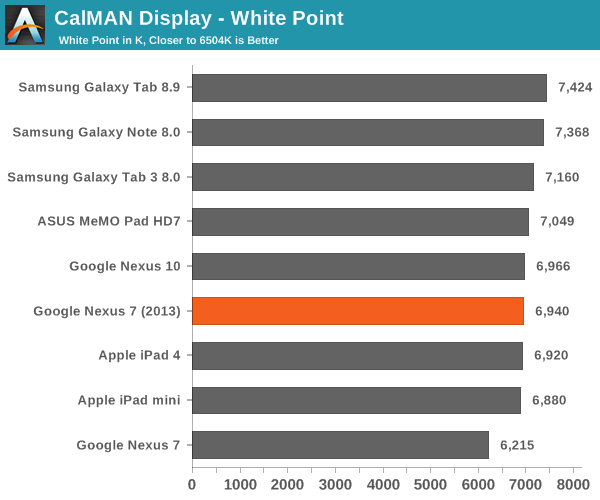
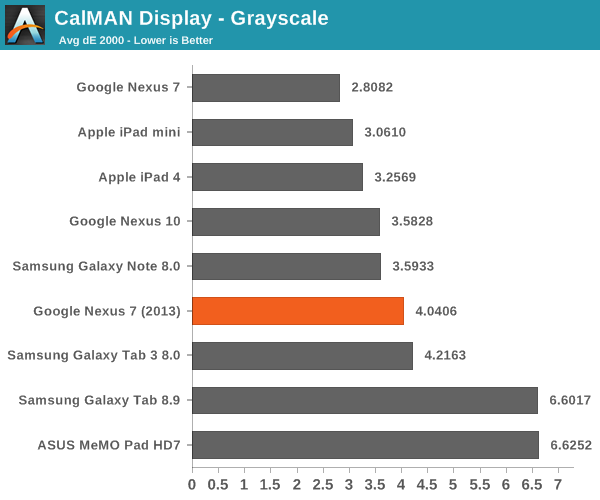
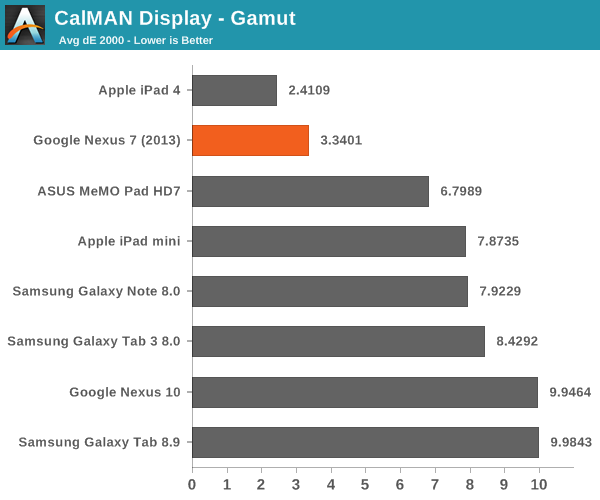
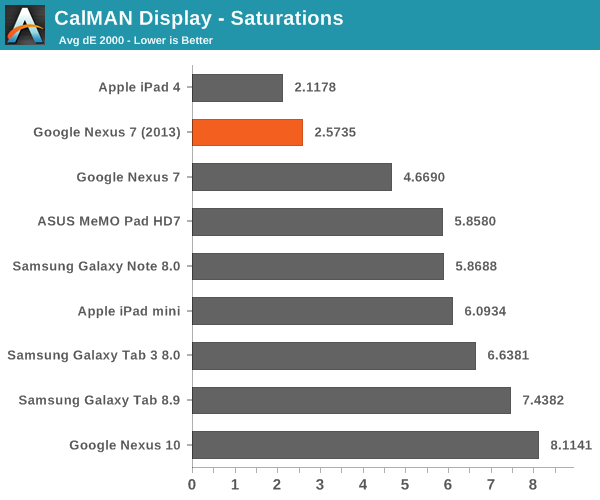
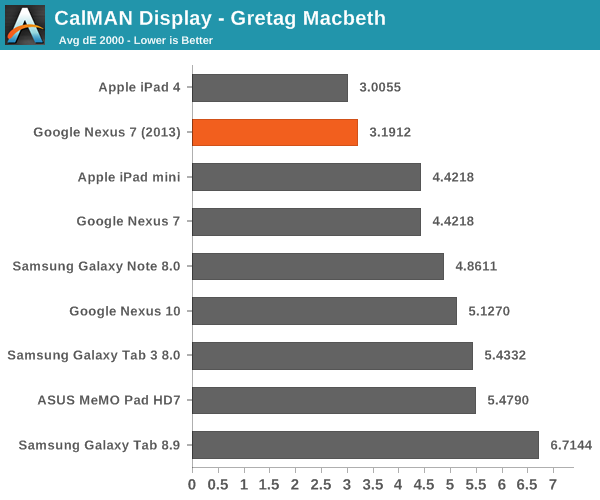
The new panel is also incredibly bright. I typically view 500 nits as the threshold for outdoor usability, and the new Nexus 7 definitely exceeds that threshold. The tablet will drink away all of your battery life if you leave it at this brightness setting indefinitely, but if you need to actually use your tablet outdoors for a while the Nexus 7 works.

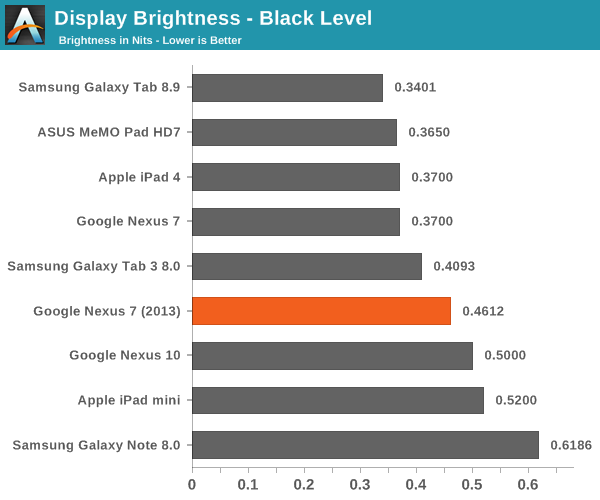
Black levels are a bit higher than on the original Nexus 7, but the resulting peak contrast ratio is still excellent:
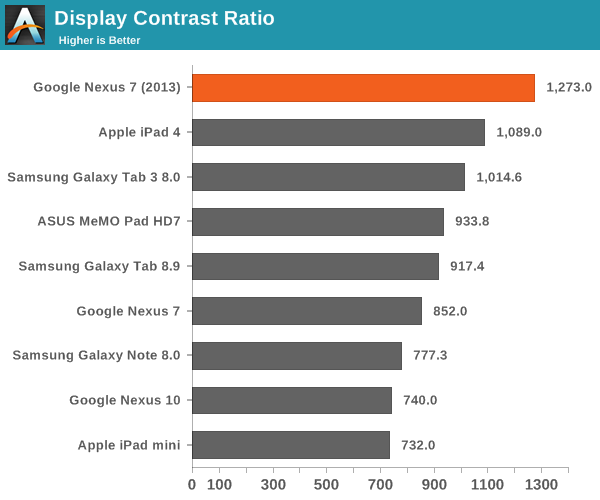
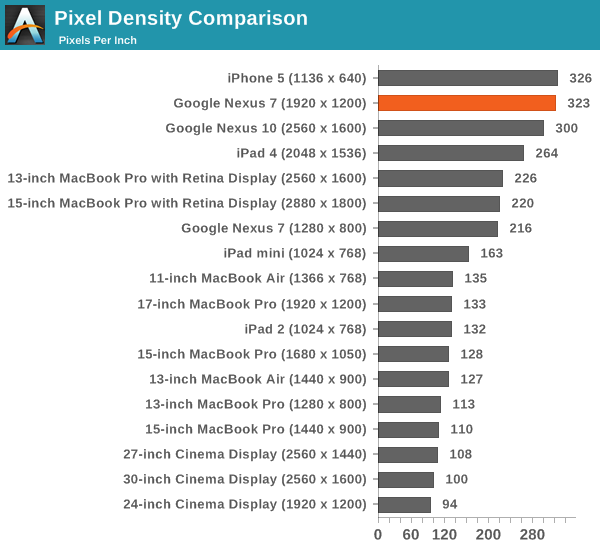
Pixel density shoots through the roof with the new Nexus 7 display as well. Brian was quick to point out that a major advantage of the Android platform is in its flexible resolution handling. The 1920 x 1200 panel presents itself as a 960 x 600 panel to web pages in Chrome, while other apps can use every last pixel for unique content (e.g. games).
The beauty of not having to double the original Nexus 7's resolution but instead settling on an in-between option like 1920 x 1200 is that Google could get away with a performance mainstream SoC instead of something ridiculously high-end.
The display looks great when viewing everything from photos and movies to web pages and eBooks. My only complaint about the Nexus 7's display is its size. A 7-inch tablet is almost pocketable (in fact I did carry it around in my pocket for a day), but the screen can feel a little cramped.


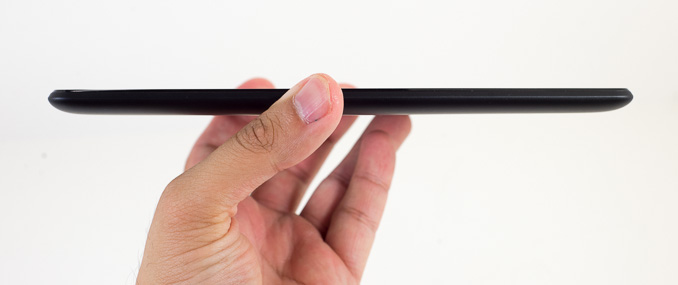
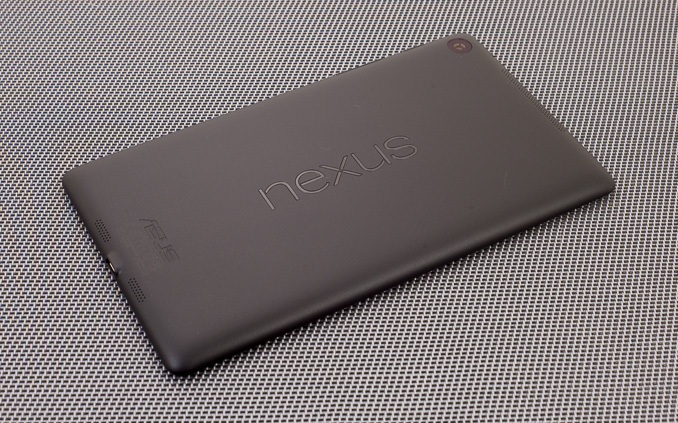
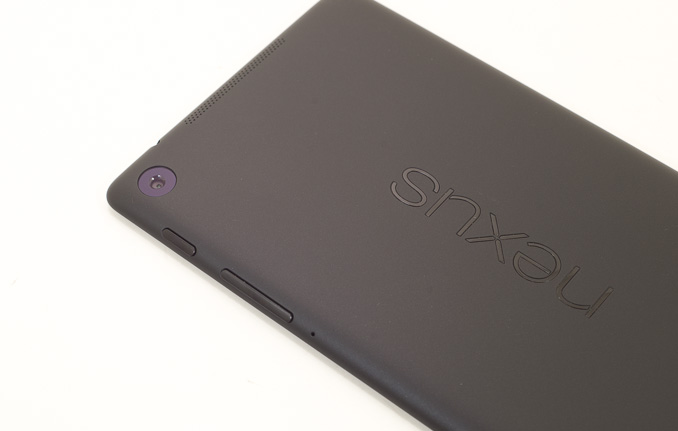


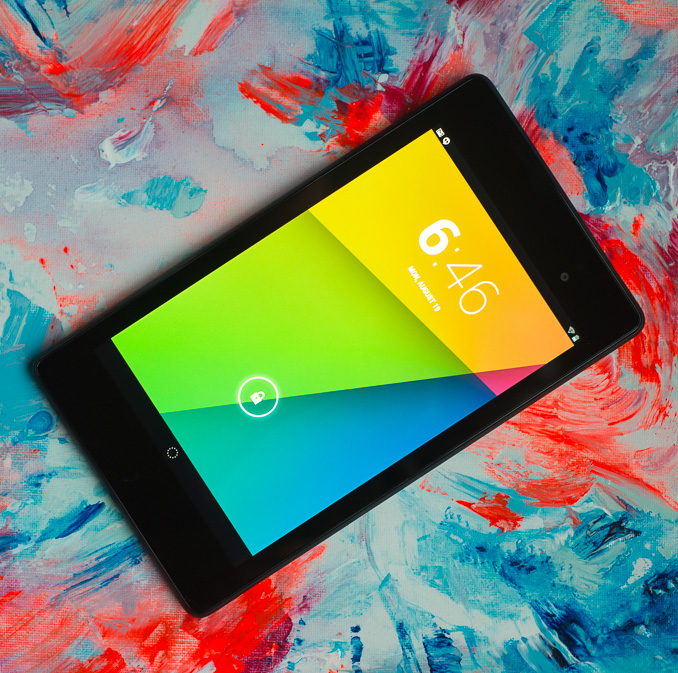
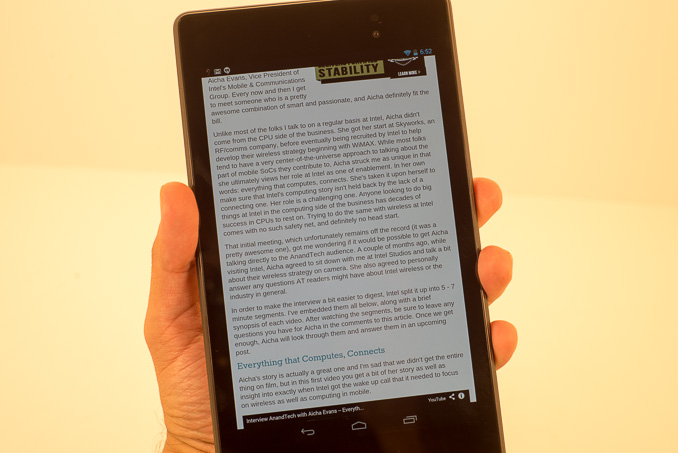
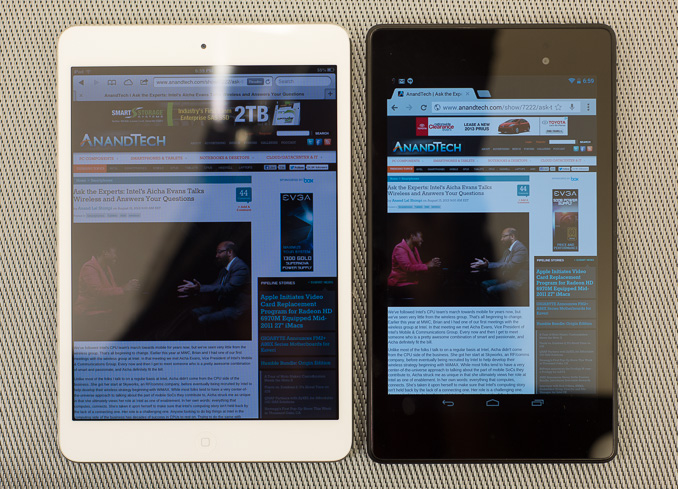








202 Comments
View All Comments
solipsism - Friday, August 23, 2013 - link
1) I'd rather take 30 seconds to enable a hotspot on my smartphone for the occasional use then pay excessive fees every month paying for a service I will rarely ever use, not to mention the HW and licensing costs associated for cellular connectivity.2) A cable? Have you ever seen an iPhone connected to an iPad to tether it? It's done via BT or WiFi. Now what happens if you have a half dozen devices using your 42Mbps cellular connection on your phone as a hotspot? Do you think they all get a constant 54Mbps connection with 802.11g? If so, you still don't WiFi works.
ShieTar - Friday, August 23, 2013 - link
There no cable, it is done via WiFi. And yes it "requires" me to carry my phone around, but so far I have not been in a situation where I left home with the tablet but without the phone.And its not like I only use this solution for the tablet, I also use the phone as mobile hotspot for my Kindle and my Laptop. And when I am on a business-travel to a foreign country with a few colleagues (which happens often enough if you work for a European company), we usually only get a single prepaid card, let one phone use it to connect to the net, and act as the mobile hotspot for everybody else.
max1001 - Friday, August 23, 2013 - link
It takes 2 secs to turn on hotspot on my nexus 4. Just unlock the phone and tap on the hotspot widget and you are done. The tablet automatically connects to it within 5-10 secs.akdj - Sunday, August 25, 2013 - link
Yep...Easy Peezy! Then, about 54 minutes later, your Nex 4's battery life is history. It's ubiquitous. Doesn't matter which OS or phone you're tethering to...tethering EATS battery life. Anand often shows battery life while tethering. It's often less than half that of actually using the phone itself to surf, check email or update your Facebook status. If both devices decide to sleep....bummer! Time to turn em both back on, reconnect and you're back up n running. Not sure what other carriers charge, but AT&T is $10 a month to add to your bucket data plan. IMHO, that up front hardware charge is a bargain when it comes down to connectivity and efficiency. I don't think I'm alone in this thought process and the last wifi only tablet I bought, I returned and 'upgraded' to the LTE version. The extra CNote was quickly forgottenESC2000 - Tuesday, September 10, 2013 - link
Tethering stays on for me even if the devices go into sleep mode. I actually need to be careful to ensure that I remember to turn tethering off because otherwise it'd just stay on allowing freeloaders to use it. I have unlimited data but still...Also I've never noticed decreased battery from tethering. I haven't paid close attention but my note II's battery has never died before the end of the day whether I tethered or not, so I'm not too worried about tethering's impact on my battery.... esp since I can easily change the battery out-_-
joos2000 - Friday, August 23, 2013 - link
I have. I got a basic "Wireless Internet" plan for my slate. It gives me more gigabytes per month than my "high usage phone plan" did. So, I've now been able to step down to a cheaper cellular plan for my phone. My cost has been status quo, but my gigabytes per month while on the go has increased.I'm in Australia though, I'm unsure how that compares to in the states.
Impulses - Saturday, August 24, 2013 - link
If you're trying to save money in the US you go with Sprint/Tmo or one of the smaller prepaid/regional carriers, and in those cases I think it's usually cheaper to pay for one of the high GB phone plans (all unlimited in Sprint's case, also available for Tmo) and run a hotspot than to go to an AT&T/VZW plan and pay extra for a tablet. I don't know if Tmo even offers a data only plan... It's all kinda backwards here, but we generally get pretty good coverage (and no roaming) across a huge swath of a continent, which people totally take for granted.max1001 - Friday, August 23, 2013 - link
.........They have an LTE version coming out very soon so how is that a major omission?
Thomaspin - Thursday, August 22, 2013 - link
I wrote a four part review based on my exepriences (my primary focus is that of a photographer and movie buff) from the perspective of someone who has never used Android before, so apologies for the relatively naïve Android content, which reflects my learning curve.My interest was in using the N7 with my existing iCloud data and so successful was the experience, and so stellar the performance of the N7, that I just sold my iPad Mini and bought a second N7 for my son.
I realize that a fairer comparison will be with the 2013 iPad, but the N7 made it unrealistic to wait, given the iCloud functionality.
My link, below, is not commercially motivated. My site carries no advertising and has no click-thorugh payment sources. Stated differently, I make exactly $zero from it. Nor do I try to compare with a dozen other tablets as, until now, my tablet world has been iPad only (iPad 1, iPad 3 and iPad Mini), and there's no way I am in competition with AT, which is my definitive source for test data.
Here it is: http://pindelski.org/Photography/2013/08/06/nexus-...
I hope it is of interest.
I am a long time AT reader, first time commentator.
max1001 - Friday, August 23, 2013 - link
If you want to be taken seriously. Keep the whole company x is evil bit out of the review. You can write the best review in the world and readers will stop taking you seriously when you start ranting.